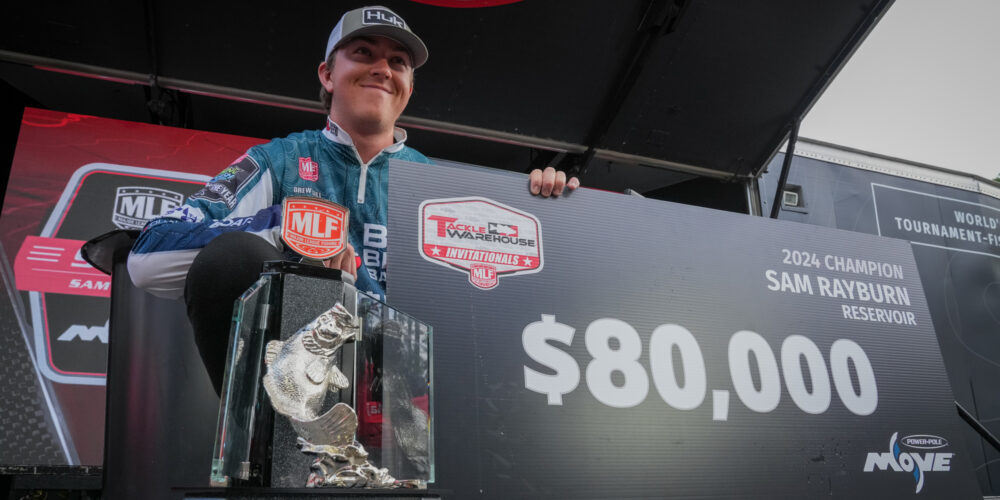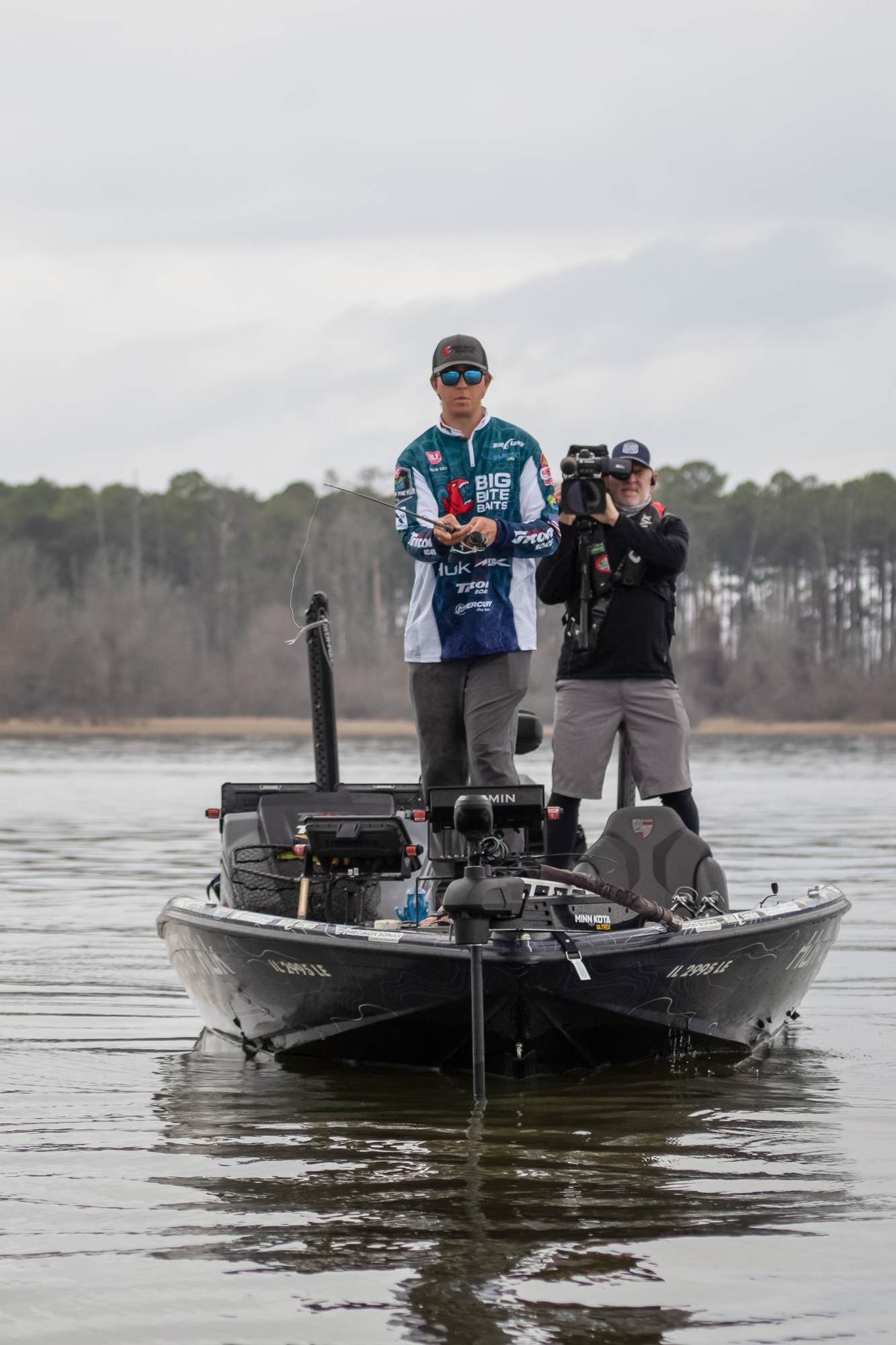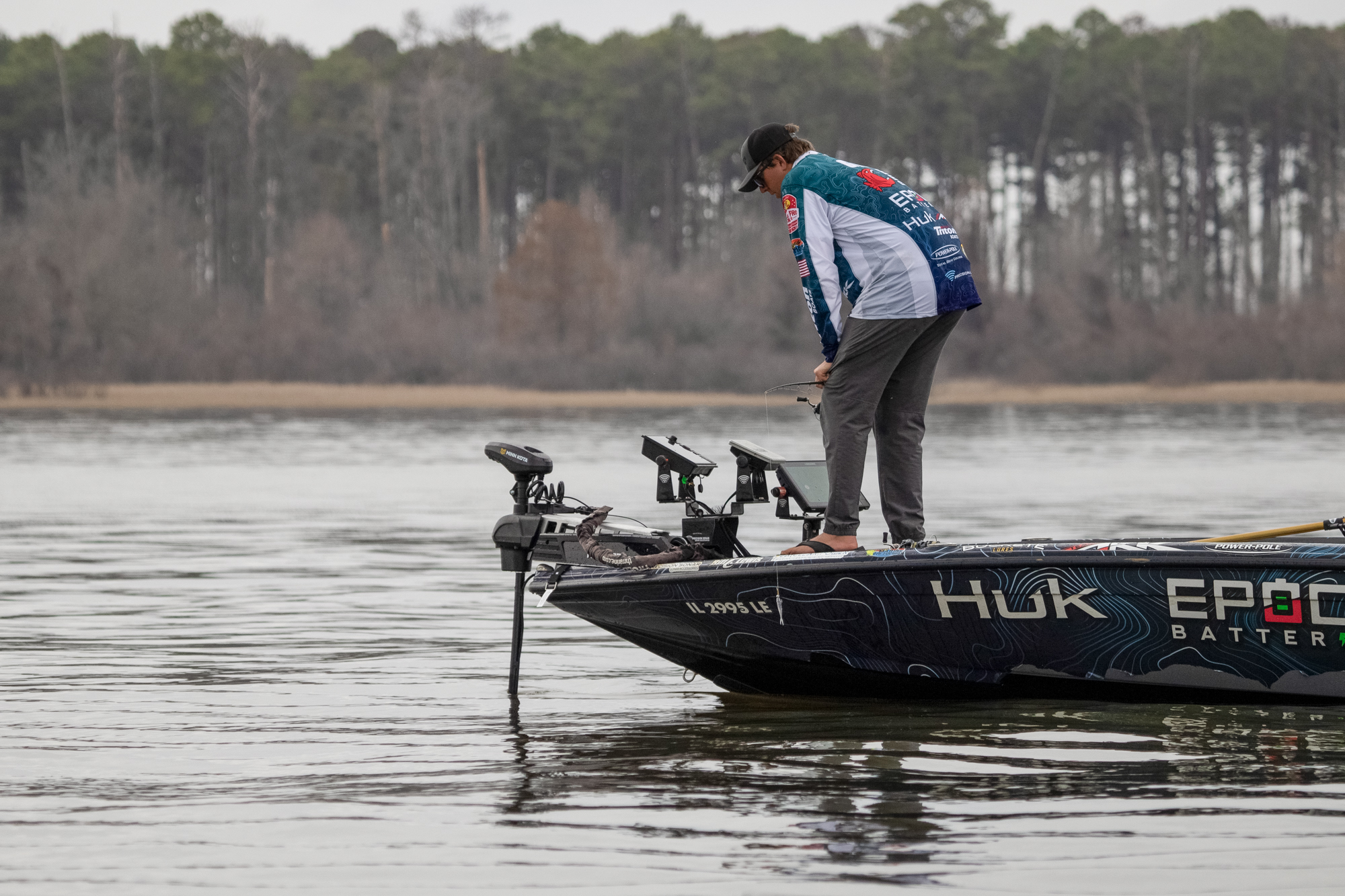Young gun Gill takes down Rayburn

BROOKELAND, Texas – Drew Gill has been on a heater for a while, and it was only a matter of time before the LiveScope whizz closed out a high-level win. Today, after sacking up 26 pounds, 3 ounces on Championship Sunday, Gill took home the title at Stop 1 Presented by Power-Pole MOVE on Sam Rayburn Reservoir with a 69-6 total.
Gill topped fellow electronics master Jake Lawrence (second, 67-15), and had enough to overcome local Marshall Hughes’ (third, 67-4) megabag on Day 2, which put him more than 6 pounds ahead of the pack initially. For the win, Gill pocketed $80,000, and locked up his 2025 REDCREST qualification early.
Though still a fledgling circuit, Gill is now the youngest to win an Invitationals event, setting the mark to beat at 21 years, 8 months. Historically speaking, when you factor in FLW Tour stats, Gill slots in between Stetson Blaylock’s win at Lake Norman in 2009 (21 years, 7 months) and Jacob Wheeler’s 2012 Forrest Wood Cup title (21 years, 10 months).
The consensus favorite for Fishing Clash Angler of the Year in the Tackle Warehouse Invitationals, Gill has started the season about as good as you can. Just last week, he finished third in the Bass Pro Tour season opener on Toledo Bend, and, for good measure, the 21-year-old also finished 19th in the Abu Garcia College Fishing National Championship with partner Evan Fields back in January.
Nothing is a really a long time coming when you’re 21, but getting over the hump for the W was a big deal for Gill.
“Any year you can do consistently well and have a lot of Top 10s is a win in itself,” Gill said. “Goal No. 1 every year is always Angler of the Year. Goal No. 1 is not to win an event. However, that is a very close goal No. 2, and to be able to accomplish that in the first event of the Invitationals season after having a third at Toledo last week, I could not be more stoked for how fishing is going right now.”
The win wasn’t exactly expected after a tough practice which featured a broken trolling motor. The usually confident angler was singing the blues.
“Coming into this one – Cole (Breeden), Nick (LeBrun), and Britt (Myers Jr.) can back me up on this – I was saying if I can get out of here with a check and go to Guntersville next week, I’ll be happy,” Gill said. “To have everything unfold the way it did this week is mind-boggling. I’m ecstatic, to say the least.”
On stage over three days, the enthusiastic young pro had a blast, as usual, and he finished off the Invitationals season opener with exactly the enthusiasm it deserved.
Adjustments and skill put Gill ahead

Love it or hate it, any list of the best anglers with forward-facing sonar has Gill on it, and he rode his signature strength to victory this week. Seeming to always find enough fish for a quality bag (and to trigger enough fish to bite), he stayed ahead of a lot of other anglers trying to do similar things.
A big part of that was recognizing that he needed to leave winter behind and get closer to the bank. Luckily, that might be where his LiveScope skills shine the most – when it comes to shallow ‘Scoping, Gill is near or at the top of the list.
“The first day of the tournament, I was trying to replicate what I found in practice,” he said. “I was catching them at the fronts of main-lake pockets and drains – the very main lake. I noticed they were going down and eating my Damiki (rig) off the bottom, and I didn’t think that was going to work all week.
“Day 2, I was throwing a Damiki and a Neko, and fishing more drains than the fronts of creeks,” Gill said. “Today, I was fishing midway back of just about every pocket I fished. These were short main-lake pockets and not big main creeks; those were unmanageable and there weren’t enough fish for me to fish a major creek. If five fish roll up into an area that’s a mile long, I’m not going to find them. If they roll up into a place that’s 400 yards long, your odds of running into those five big ones is pretty high.”
For his jighead minnow, Gill used a 3/16-ounce head and a 4-inch bait. For his Neko, he used a 6-inch Big Bite Baits Shaking Squirrel Worm, a 1/8-ounce weight and a No. 1 Roboworm Rebarb Hook.
On the last two days, when Gill honed his approach, he was fishing specifically for bass that were low in the water column and not too far from classic later-winter and prespawn things.
“I was fishing some transition areas, basically – places that were adjacent to a contour or a drain, and I had to have some sort of cover in conjunction with that that would lead them along an edge,” Gill said. “Something that would lead them swimming one direction or another and keep them on a path that I could predict. I was running edges of grass, edges of rock, edges where sand dropped off a couple feet; places where bass should travel along, and the few good ones I was around, I could run right into them.
“Almost every big one I caught this week ate it off the bottom,” he said. “I was in about 7 to 14 feet of water most of them time, and generally they would be 2 or 3 feet above the bottom. Not suspended, but hovering almost, like a maglev train. They’d follow it down … ‘bonk, zzzzzzzzz.’”
‘Scoping out the competition

For his LiveScope settings, Gill ran his forward range at 70 feet, his down range at 21 feet, his color gain at 75, his gain at 72, and he had his TVG on low, with his ghost reject and noise reject off. He only cast when he saw a fish, and he figures he caught about 160 fish over three days, though many were not very large.
The last few years have seen a lot of young anglers excel on big stages. Some of it is collegiate fishing, some of it is skill with electronics, some of it is networking. A lot of it is time on the water with forward-facing sonar, which may have taught us more about bass behavior than every magazine ever printed. Gill is the perfect storm, a passionate young angler who has learned as much about bass in the last few years as many will learn in a lifetime.
“When you spend as many hours watching fish behave in their natural environment as I have, you’re destined to learn a lot about fish behavior, and you’re going to be really good at reading their movements,” Gill said. “I’ve spent a lot of time watching fish, not listening to fishermen or the logic built up in bass fishing lore. I’ve just gone out and watched fish behave, around their food, with the cover they relate to, with the contours they use. When you understand that much about fish, they become pretty predictable.”
Then, you just have to be super good at fishing, don’t get unlucky, make all the right decisions and beat a field that is trying to do all the same stuff. This week, Gill made it look easy.
Top 10 pros
1. Drew Gill – 69 – 6 (15) – $80,000
2. Jake Lawrence – 67 – 15 (15) – $50,000
3. Marshall Hughes – 67 – 4 (15) – $20,000
4. Cal Lane – 65 – 5 (15) – $18,000
5. Keith Poche – 64 – 15 (15) – $17,000
6. Nick Hatfield – 62 – 7 (15) – $17,000
7. Mark Condron – 59 – 3 (15) – $15,000
8. Nick LeBrun – 58 – 9 (15) – $14,000
9. Alec Morrison – 58 – 0 (15) – $13,000
10. Ramie Colson Jr. – 58 – 0 (15) – $12,000